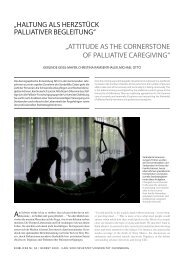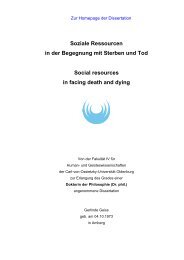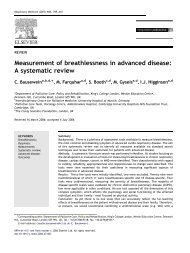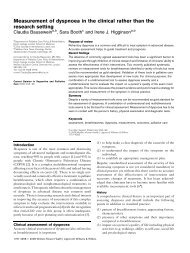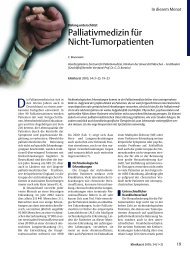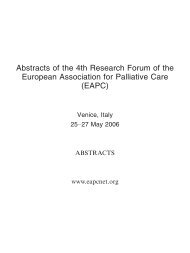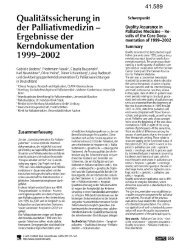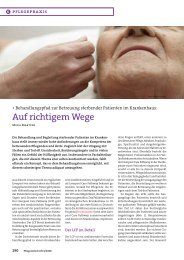EAPC - ipac
EAPC - ipac
EAPC - ipac
Create successful ePaper yourself
Turn your PDF publications into a flip-book with our unique Google optimized e-Paper software.
432 <strong>EAPC</strong> Abstracts<br />
Joris Gielen K.U. Leuven Leuven BELGIUM<br />
Stef Van den Branden K.U. Leuven Leuven BELGIUM<br />
Background: Several studies have already investigated attitudes of medical<br />
professionals towards end-of-life issues. Less research has been conducted<br />
concerning the attitudes of palliative care professionals, especially regarding<br />
palliative sedation. In 2006 we undertook a quantitative study of attitudes of<br />
pallitive care physicians and nurses towards palliative sedation. Methods: An<br />
anonymous questionnaire was sent to all physicians (147) and nurses (589)<br />
employed in palliative care teams and institutions in Flanders (Belgium). The<br />
questionnaire contained a demographic part, and an attitudinal part, consisting<br />
of a long series of ethical statements using a five-point Likert-scale. To<br />
divide physicians and nurses into different attitudinal groups a latent class<br />
analysis was fitted with an EM-algorithm. Results: 70.5% of the nurses<br />
(n=415) and 67.3% of the physicians (n=99) responded. Only 7% of the<br />
respondents prefers euthanasia to palliative sedation. Yet, most physicians<br />
and nurses (64%) think palliative sedation does not render euthanasia<br />
superfluous. 94% is convinced that artificial nutrition and hydration is not a<br />
proper treatment in the case of deep continuous sedation. 75% agrees that<br />
palliative sedation can only be administered safely when a specialised palliative<br />
care team is involved in the decision making process. Two clusters were<br />
found: advocates of deep sedation (43.8%, n=215) and respondents restricting<br />
the application of deep sedation (56.2%, n=276). There were no statistically<br />
significant differences between both clusters regarding gender, age,<br />
profession and years of experience in palliative care. Conclusions: The<br />
respondents’ attitudes toward palliative sedation are balanced. Although they<br />
consider palliative sedation a good treatment, they do not believe palliative<br />
sedation offers a satisfactory solution in all circumstances. They are cautious<br />
about applying deep sedation. Funding: Research Foundation Flanders.<br />
110 Oral Presentation<br />
Palliative Sedation<br />
Palliative sedation (PS): comparison of practice between 2001<br />
and 2006<br />
Authors: Karine Moynier-Vantieghem Réhabilitation et Gériatrie Service<br />
de Médecine Palliative – CESCO SWITZERLAND<br />
Gilbert B Zulian Service de Médecine Palliative – CESCO Collonge-<br />
Bellerive SWITZERLAND<br />
Sophie Pautex Service de Médecine Palliative – CESCO Collonge-<br />
Bellerive SWITZERLAND<br />
Yolanda Eespolio Desbaillet Service de Médecine Palliative – CESCO<br />
Collonge-Bellerive SWITZERLAND<br />
Catherine Weber Service de Médecine Palliative – CESCO Collonge-<br />
Bellerive SWITZERLAND<br />
Background: The aim of this study is to compare practice between 2001<br />
and 2006. Is PS more frequent Are situations more complex Are indications<br />
different Are guidelines useful Methods: Files from all deceased<br />
patients during the years 2001 and 2006 were retrospectively analyzed. PS<br />
performed with either midazolam, diazepam and/or levopromazine were<br />
identified. Indications, route of administration, duration of PS were determined<br />
according to the following definition: PS = administration of sedative<br />
drugs to adequately relieve one or more refractory symptoms of<br />
patients with advanced disease and limited life expectancy and to reduce<br />
consciousness either temporarily or permanently. Results: In 2001, 309 persons<br />
died, 8 (5 females) received PS (2.5%), mean age was 67.8 years.<br />
6 had advanced cancer and 2 cardio-pulmonary failures. Refractory dyspnoea,<br />
insomnia and psychomotor agitation indicated intravenous/subcutaneous<br />
midazolam or intrarectal diazepam PS which was terminal in 5 cases<br />
and transitory in 3. Sleep induction failed in one midazolam case. In 2006,<br />
297 persons died, 12 (4 females) received PS (4%). Indication for PS was<br />
refractory symptoms: dyspnoea, psychomotor agitation, epilepsy, anxiety.<br />
Data will be reported as above. Differences of practice will be analysed.<br />
Conclusions: Number of PS has not increase as much as expected over the<br />
past years despite higher complexity of patients. However, misinterpretation<br />
of PS, which is performed after strict indications under careful supervision,<br />
with euthanasia may persist among caregivers. Carefully monitor<br />
our practice appears an appropriate way to avoid the risk of confusion.<br />
111 Oral Presentation<br />
Palliative Sedation<br />
Palliative sedation therapy does not hasten death<br />
Presenting author: Luigi Montanari<br />
Authors: Marco Maltoni Palliative Care Unit Valerio Grassi Hospice,<br />
AUSL Forlì ITALY<br />
Emanuela Scarpi Istituto Scientifico Romagnolo per lo Studio e la Cura dei<br />
Tumori, Unit of Biostatistics Meldola (FC) ITALY<br />
Oriana Nanni Istituto Scientifico Romagnolo per lo Studio e la Cura dei<br />
Tumori, Unit of Biostatistics Meldola (FC) ITALY<br />
Lino Piccinini Hospice Ospedaliero, Cancer Center Modena ITALY<br />
Francesca Martini Valerio Grassi Hospice, Palliative Care Unit<br />
Forlimpopoli (FC) ITALY<br />
Cristina Pittureri Hospice Savignano sul Rubicone, Palliative Care Unit<br />
Savignano sul Rubicone (FC) ITALY<br />
Paola Turci Hospice Savignano sul Rubicone, Palliative Care Unit<br />
Savignano sul Rubicone (FC) ITALY<br />
Dino Amadori Istituto Scientifico Romagnolo per lo Studio e la Cura dei<br />
Tumori Meldola (FC) ITALY<br />
Luigi Montanari San Domenico Hospice, Palliative Care Unit Lugo (RA)<br />
ITALY<br />
Background: Palliative Sedation Therapy (PST) is indicated for and used to<br />
control refractory symptoms in cancer patients who have been inserted into<br />
a palliative care programme. PST is often considered to be responsible for<br />
speeding up death and has been defined by some as slow euthanasia.<br />
Methods: The primary objective of this multi-centre, observational study is<br />
to evaluate the overall survival of two cohorts of patients prospectively<br />
recruited in several Hospices, one given palliative sedation and the other<br />
managed as per routine hospice practice. The patients were matched for sex,<br />
age class (¡Ü65, >65 years), reason for admission (psychosocial, uncontrolled<br />
symptom, terminal phase), Karnofsky Performance Status (10–20,<br />
30–40, ¡Ý50), and outcome of admission. Overall Survival was estimated<br />
using the Kaplan-Meier method and the comparison of survival curves was<br />
performed by log-rank test. Results: From March 2005 to December 2006,<br />
518 patients of either sex and any age were recruited; 267 belonged to the<br />
cohort of sedated patients (A) and 251 to the cohort of non sedated patients<br />
(B). The percentage of sedated patients out of the entire population assisted<br />
during the period of the study was 25.1%. The mean duration of sedation<br />
was 4 days, while the median duration was 2 days. Median survival from the<br />
time of admission to the hospice for cohort A patients was 12 days (95% CI:<br />
10–14), while that of cohort B patients was 9 days (95% CI: 8–11)<br />
(logrank=0.95, p=0.330) (unadjusted HR=0.92, 95% CI: 0.77–1.09).<br />
Conclusions: Our results indicate that PST does not shorten survival when<br />
carried out in an appropriate manner and that it does not require the principle<br />
of double effect to be justified ethically. Supported by Istituto Scientifico<br />
Romagnolo per lo Studio e la Cura dei Tumori, Meldola (FC), Italy.<br />
112 Oral Presentation<br />
Palliative Sedation<br />
The use of continuous deep sedation for patients nearing death<br />
in the netherlands: a descriptive study<br />
Authors: Judith Rietjens Public Health Erasmus MC NETHERLANDS<br />
Agnes van der Heide Department of Public Health, Erasmus MC Rotterdam<br />
NETHERLANDS<br />
Bregje Onwuteaka-Philipsen Department of Public and Occupational<br />
Health, Institute for Research in Extramural Medicine, VUMC Amsterdam<br />
NETHERLANDS<br />
Johannes van Delden· Julius Centre for Health Sciences and Primary Care,<br />
University Medical Centre Utrecht Utrecht NETHERLANDS<br />
Paul van der Maas Department of Public Health, Erasmus MC Rotterdam<br />
NETHERLANDS<br />
Hilde Buiting Department of Public Health, Erasmus MC Rotterdam<br />
NETHERLANDS



